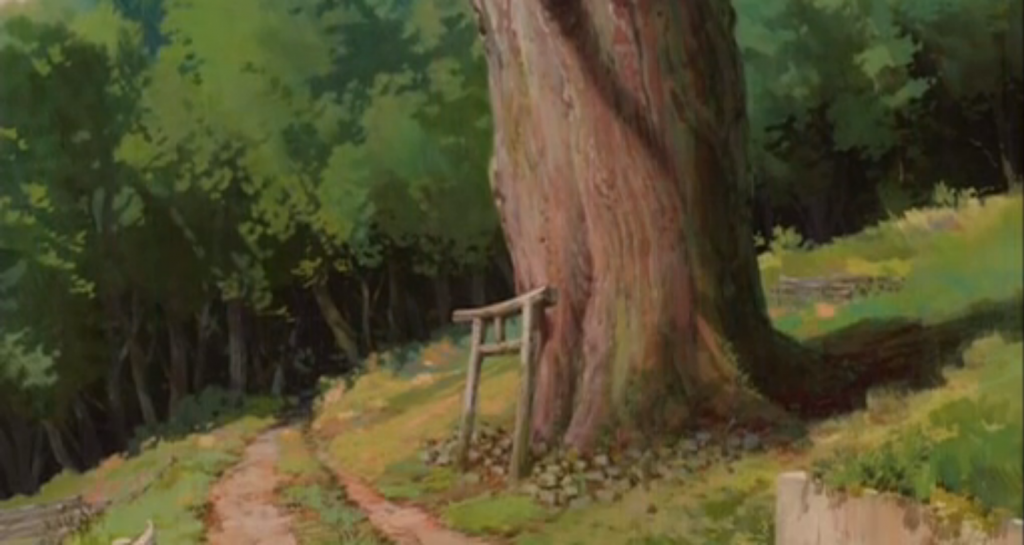
Fig 1c - symbolic marker of an entrance into another realm
The Japanese director of animated films Hayao Miyazaki received an Honorary Award from the Academy of Motion Picture Arts and Sciences on Nov. 8 at a private dinner event. “My wife tells me I’m a very lucky man,” said Miyazaki, 73. “I was fortunate to be part of the final era where movies were made through the use of paper, pencil and film.” It’s only the second time that a Japanese national has received such an award, the first being Akira Kurosawa in 1990. By way of congratulations, Green Shinto is here reposting a paper by Par van Zoelen about the spiritual nature of Miyazaki’s movies. For the original, please click here. All illustrations courtesy of the author.
*******************************************************
Hayao Miyazaki: Recovery of Japanese Cultural Values
Par van Zoelen, Aurora – 13 December 2012
Hayao Miyazaki is arguably the best contemporary Japanese animator. Over the last 30 years he has developed a particular style, both aesthetically and through his work habits, that separates him from other animators. Miyazaki works without scripts, so his stories develop in the production stage of each movie. His films have recurrent themes such as ecology, opposition to war and state, and a recovery of old Japanese values in today’s context. These values are deeply rooted in Shinto and Buddhism. Miyazaki materializes ideas from these two life philosophies and adds his own personal experiences either in characters or in scenarios.
This essay revolves around four images: a 14th century Buddhist mandala, and three stills from the movies Princess Mononoke (1997), My neighbor Totoro (1988) and Spirited Away (2001). The characters in Miyazaki’s movies interact with kami (gods or spirits) because they are placed in sacred sites or areas that facilitate this contact. In Princess Mononoke it is the mountain, in My Neighbor Totoro, a tree and in Spirited Away, a kami bathhouse. Miyazaki employs fundamental Shinto symbols in his movies in order to retrieve Japan’s cultural heritage in today’s context.
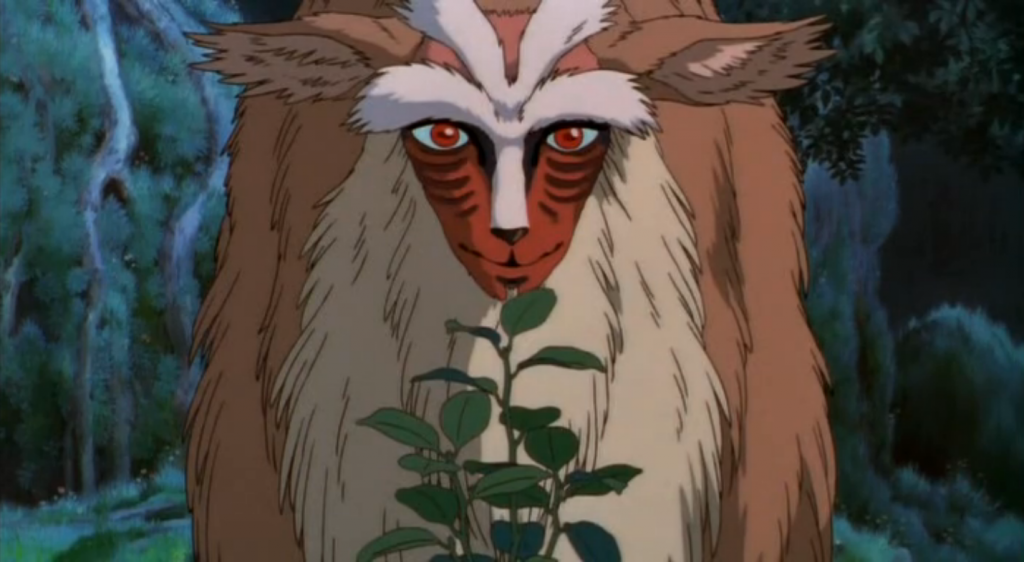
The spiritually charged world of Princess Mononoke
Shinto predates historical records. It is Japan’s native belief system, which consists of honoring nature and kami, purification rituals and continuity between the deific and profane space within the world. Traditionally, Shinto was an oral transmitted religion whose fundamental teaching was to respect all living things. It is devoid of scriptures and its rituals have changed over time.
In history, Shinto has been supported and suppressed by the standing government but without success to either eradicate it or elevate it as the only religion in Japan. It has however, survived into the 21st century. Buddhism was introduced around the sixth century and has too become a predominant ideology in Japan’s belief system. Moreover the two religions have adopted ideas from each other:
“Buddhist figures adopted complementary Shinto identities and Shinto kami were thought to strive toward Buddhist enlightenment. […] It was not until the arrival and influence of Buddhism, with its long tradition[al] of producing anthropomorphic representations of Buddhist deities, that statues and paintings of Shinto divinities started to be produced, around the eighth century.”[1]
By complementing each other, these religions have been able to appeal to a larger population. Moreover, Shinto gained the ability to communicate its ideas through new forms of representation and specific symbols.
The definition of sacred space in Japanese religions is very important. One can interact with kami and other spirits in areas or with objects that serve as mediums for this communication. A ‘sacred site’ is “a well-structured, clearly delimited space seen as the actual residence of a divinity. The sacred site is the oldest form of sacred space in Japan, which we find emerging out of the early myths and Shinto rituals.”[2]
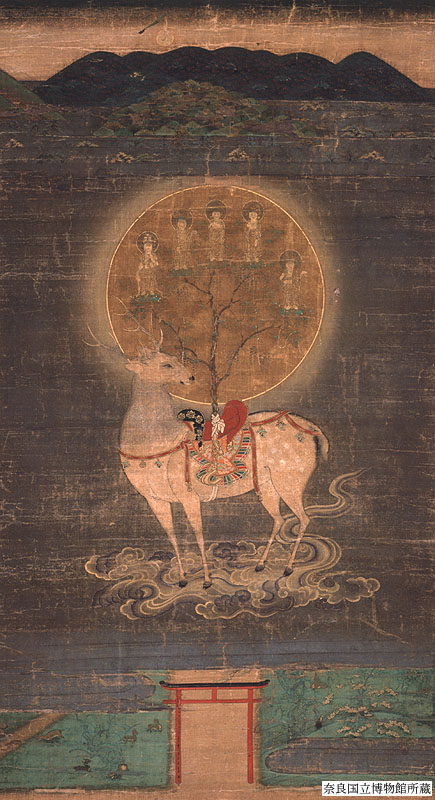
Fig. 1 - Kasuga Deer Mandala
From the interaction between Shinto and Buddhism appeared the idea of a ‘sacred area’, which consists of the territory travelled by pilgrims into the mountain. A sacred site is a specific site or object where a kami was thought to have materialized whereas the sacred area is a larger space, for example a mountain, which has to do with the divine. The mandala, a traditional representation of the residence of the Buddha, is a projection of the sacred area. It depicts symbols of the journey and the aim of the pilgrim.
Although the mandala comes from a Buddhist tradition, the imagery of Fig 1 is heavily influenced by symbols of Shinto. For instance, nature is the overpowering symbol. In relation to the five Buddha depicted, the deer, the mountain and the tree appear much larger. The Kasuga Deer Mandala is read vertically from the bottom to the top. One starts at the bottom center of the image passing through the torii, a Shinto symbol and architectural piece that delineates the space between the profane and the sacred. This symbol indicates that one changes from the realm of men to the realm of the gods. It then continues in vertical ascent to the deer, a sacred animal and the tree on its saddle, also a sacred symbol. The golden circle symbolized either the sun or the moon, depending on the interpretation, and the five Buddha within are representations of five shrines. Lastly, at the very top are the mountains, mysterious areas where humans could become in contact with the divine.
The vertical reading of the image is evocative of the Japanese family system ‘ie’, where unborn members of the family are represented at the bottom and ancestors at the top with the living in the middle in the realm of men. To enter either category, one must pass through a threshold much like when a pilgrim passes through a torii to enter the foreign land of the mountain. Miyazaki uses Shinto symbols as the torii in his movie Spirited Away (2001). At the beginning of the film the characters pass by an old torii (Fig 1c) that is indicative of an entrance into a sacred site. It is the delineation between the mundane and a space where the characters will interact with kami.
The early attitudes towards mountains as sacred spaces have to do with the geographical location of humans. People lived and worked in plains while mountains were “untouched and were areas of non activity. Corpses were abandoned or buried on mountains; hence the mountain was seen as a space whose nature was Other (not belonging to common categories of experience within the profane).”[3]
Figure 2 is a still from the movie Princess Mononoke, a historical epic set in the Muromachi period (1333-1568) the same period as the Kasuga Deer Mandala. This time period is the threshold between rural Japan and the beginnings of urbanization. It is the time when gods and human were at war for the possession of nature and humans entered and destroyed the realm of gods. The first function of Figure 2 is to depict the Japanese mountainous landscape and how forests overwhelm these areas. The trees in the foreground are later lost in perspective to the receding mountains but one can assume that they are as occupied by nature as the plants depicted in the forefront. It is important to note the lack of any source of artificial light. Only the moon illuminates the picture. Both of these elements support the impression of a natural world yet untouched by urbanization.
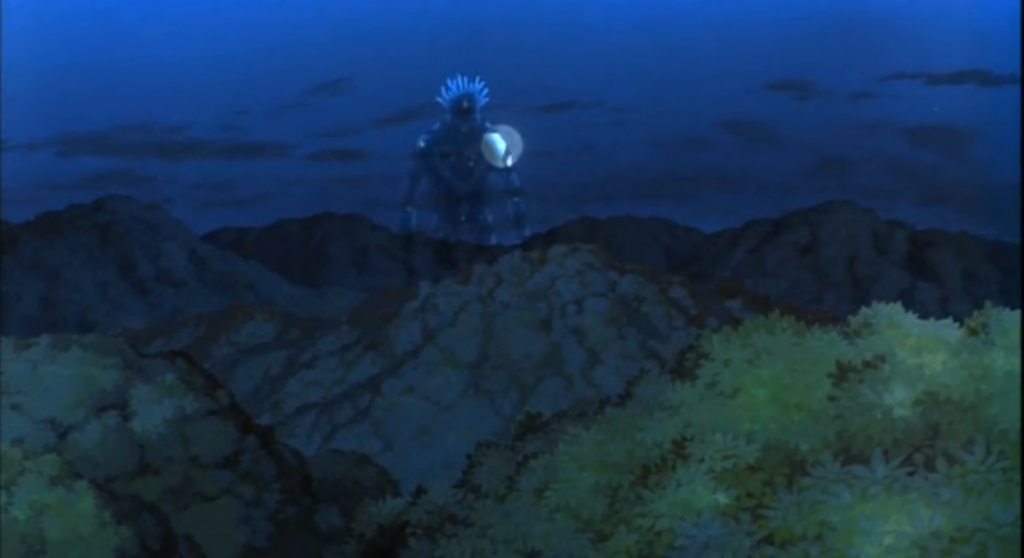
Fig. 2 - the giant from Princess Mononoke
In this night still, Miyazaki visualizes a daidarabotchi -a legend of a giant, who creates lakes with his footsteps-. Miyazaki attributes life and death to this forest god, who during the day is transforms into a shishigami (fig 2b). In daylight it embodies the shape of a deer with a traditional Japanese mask for a face that moves within a closed-off space within the mountain. At night, it changes into to the giant Night Walker, as tall as the mountains. He is of another nature as is the space around him; he is a spirit, a god, and a mountain.
The depiction of the daidarabotchi illustrates the earlier ideas of Shinto that mountain were sacred spaces, which gods took as residences. Miyazaki expands this view and implies that the gods in the mountains can affect directly the life and death of the immediate surroundings. During the film, a gun (a man-made tool) severs the forest god’s head and all nature around him dies too. The principal characters have to then reunite the god with its head in order to appease the destruction. It’s clear that Miyazaki is providing a commentary on the importance to respect nature.
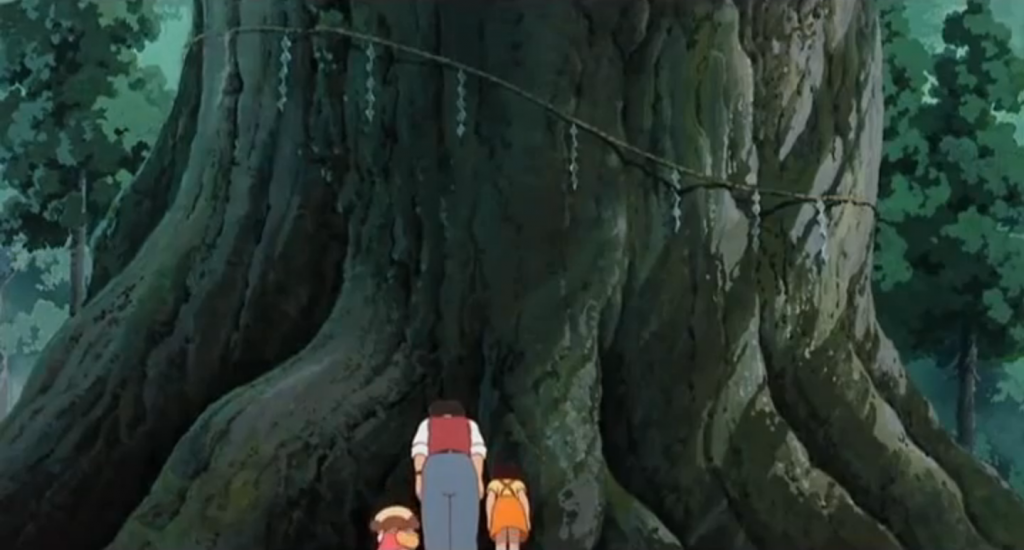
Fig 3 - My Neighbor Totoro
Miyazaki’s films display the rich cultural heritage of Japanese religions and belief systems. The film My Neighbor Totoro takes place in a rural setting, where superstitions regarding kami are still common in today’s Japan. The movie revolves around the adventures that two small girls share with the spirit of a tree. At the beginning of the movie the father talks to them about the great tree that overshadows their house. He tells the girls that “It’s been around since long ago, back in the time when trees and people used to be friends.”[4] This dialogue is reminiscent of the fundamental principle of Shinto belief: to respect all living things.
In Figure 3, the characters are paying their respects to the spirit of the tree and asking him to look after them. As in the Kasuga Deer Mandala the representation of nature, in this case the tree, outsizes the representation of people. Another symbol from Shinto employed in this image is the rope with white paper zigzags around the tree. The rope or “Shimenawa […] is a Shinto device for marking off the sacred from the secular.”[5] Moreover, “in the mythological age, a sacred site surrounded by trees was set aside as a place to invoke the kami for worship. These sacred groves themselves were shrines. The primitive Japanese believed that they could invoke kami within the trees, so they fixed pieces of cloth and paper, called shide, on the trees to guide the kami.”[6]
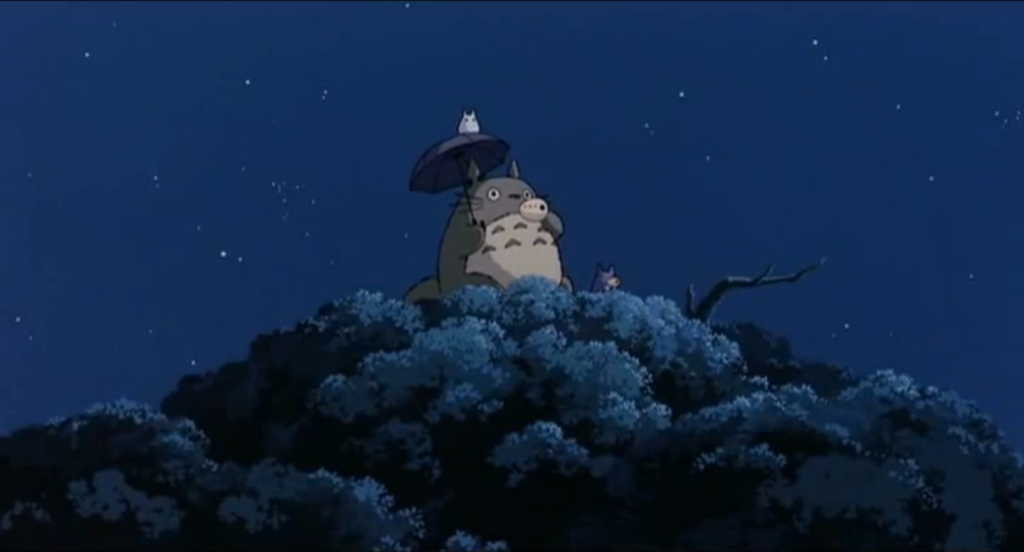
Scene from Totoro
The interaction that the characters have with the forest kami Totoro revolves around this tree. In the movie, it serves as his dwelling to which the two girls are allowed to enter because of their pure nature. In Shinto an individual must have kokoro, a condition where the individual demonstrates a pure heart and mind, in order to interact with kami.[7]
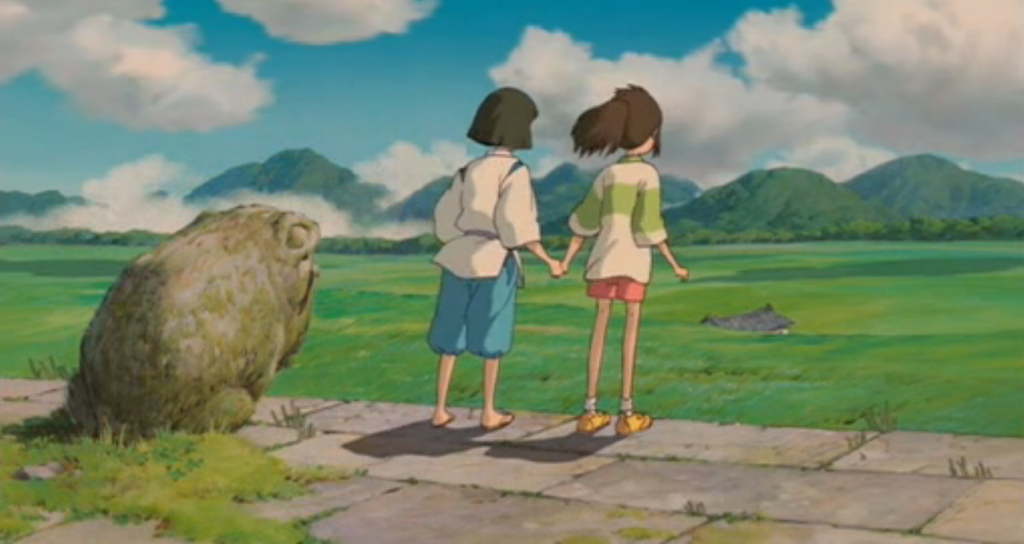
Fig 4 - Spirited Away
In his film Spirited Away Miyazaki indicates that the younger generation (of Japanese children) are not aware of their cultural heritage. The character of Chihiro is inspired in the daughter of a friend. He was interested in this age group because “girls like her see films that contain characters their age, but they can’t identify with them, because they are imaginary characters that don’t resemble them at all.”[8]
Chihiro is an ordinary girl that becomes a capable person by surpassing the challenges she encounters in the world of the kami. Spirited Away is one of the heaviest religion-loaded movies from Miyazaki. He incorporated many of the precepts and symbols from Shinto and Buddhism.
Figure 4 depicts the end of Chihiro’s journey. She is holding hands with the river spirit that has helped her throughout the movie. She is looking forward into the green field and to the continuation of her own journey, her life, with the teachings and experiences that she had throughout the movie. The frog statue is reminiscent of statues in the entrances of shrines or statues placed by roads to assure the traveler that he is safe. In the background Miyazaki includes the mountains, to remind that the setting is Japan. Oddly enough there is only one house in the expanse shown, a house part of the world of the kami, everything else is devoid of architecture, alluding to nature.
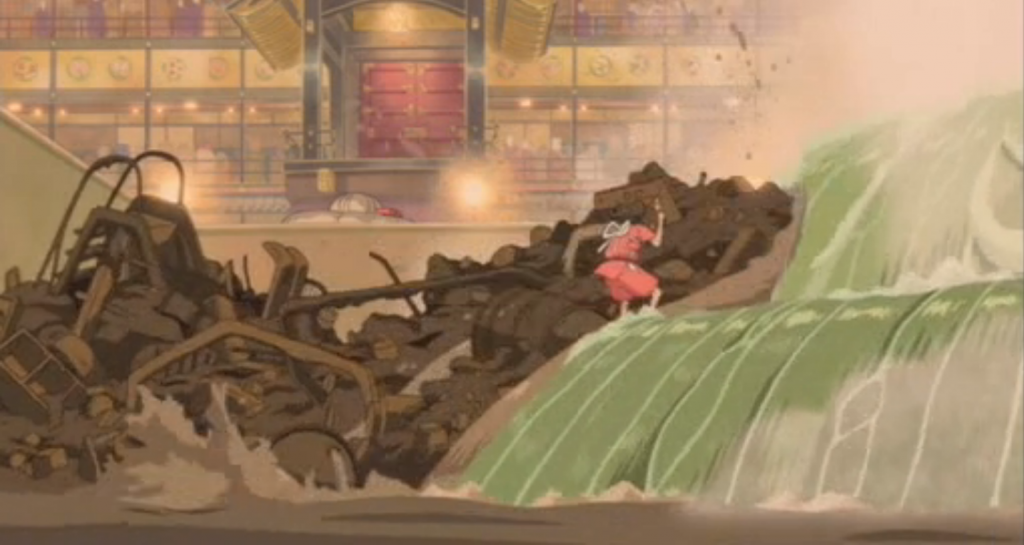
Fig 4b - the bathhouse in Spirited Away
Spirited Away depicts another important idea from Shinto. Shinto states that all living things and natural phenomena, like a tree, a person or a river are inherently pure but can become contaminated. The movie’s setting is a bathhouse (Figure 4b) to purify gods and spirits so they can again do good to the world and humans. A challenge that Chihiro overpasses is cleaning a ‘stink god’ that turns out to be a polluted river. This segment of the movie comes from a personal experience of Miyazaki. A river near his house was excessively polluted and when they decided to clean it up a bicycle and other waste was removed.
Hayao Miyazaki illustrates the precepts of Shinto and Buddhism in his films in order to re-appropriate their values in today’s context. He makes direct links to Japan’s history in plotlines like Princess Mononoke’s and incorporates religious symbols and imagery in movies as My Neighbor Totoro and Spirited Away. To his Japanese audience, he is reminding them of their rich cultural heritage while to foreigners he is transmitting meaningful universal values. Shinto originated even before Japanese writing was created and yet it has survived to the 21st century where capitalism is an antagonist to its teachings. The ideas of respect towards all living things are especially significant in the context of a post-war Japan and to create a new national identity, which its people may be proud of. Hayao Miyazaki recalls Shinto’s long-lasting ideas so that they can be exercised in a contemporary setting.
[1] Elizabeth Hammer, “Shinto: A Japanese Religion.” Asia Society. http://asiasociety.org/countries/religions-philosophies/shinto. [Accessed 26 November 2012].
[2] Allan G. Grapard, “Flying Mountains and Walkers of Emptiness: Towards a Definition of Sacred Space in Japanese Religions.” History of Religions, Vol. 21, No. 3 (Feb., 1982): 196.
[3] Allan G. Grapard, “Flying Mountains and Walkers of Emptiness: Towards a Definition of Sacred Space in Japanese Religions.” History of Religions, Vol. 21, No. 3 (Feb., 1982): 200.
[4] Hayao Miyazaki, My Neighbor Totoro. Internet. Directed by Hayao Miyazaki. Japan:Studio Ghibli, 1988.
[5] Editorial Staff, “Shinto Symbols (Continued)” Contemporary Religions in Japan, Vol. 7, No. 2 (Jun., 1966): 100.
[6] Ibid, 94.
[7] Boyd, James W. and Tetsuya Nishimura. “Shinto Perspectives in Miyazaki’s Anime Film “Spirited Away”.” The Journal of Religion and Film, Vol. 8, No. 2 (October 2004): 3.
[8] Tom Mes. “Interviews: Hayao Miyazaki.” Midnight Eye: Visions of Japanese Cinema. http://www.midnighteye.com/interviews/hayao-miyazaki/. Accessed 4 December 2012.

One of the public broadcasting stations in Australia is currently screening five Miyazaki movies over five Saturday evenings. They are at a child friendly time so that the younger generation can experience their magic. The screenings are a wonderful opportunity to enjoy some of the Miyazaki movies I haven’t seen for some time, such as ‘My Neighbour Totoro’ and ‘Spirited Away’, as well as new ones to me such as Kiki’s Delivery Service. Having learnt more about Shinto and Japan in recent years I’m able to look at the movies in a new light, as well as continue to marvel at the beauty of the animation. Miyazaki truly deserved the Honorary Award. I’ve also recently seen the recently released movie ‘The Tale of Princess Kaguya’ by Isao Takahata, Miyazaki’s long-time collaborator. As with Miyazaki’s movies, the animation and story-telling were sublime. The references to Shinto didn’t appear as obvious in Princess Kaguya, while the Buddhist references were quite strong, particularly in the end sequence. It was an interesting contrast. The only disappointment with all of these movies is that they are screening the versions that have been dubbed with American accents, rather than using the ones with Sub-titles. Retaining the original Japanese is important as the intonation of the voices has meaning and power, even if one can’t understand the words directly.
Thank you for that, Jann… It certainly seems a pity they are not using subtitles, but for some reasons television companies often seem to prefer to dub. I’m not sure why… they often do it on foreign films shown on tv here in Japan too. As you say, the Shinto themes are much more pronounced in some films than others… I can think of a couple at least which seem to have no relationship to Shinto at all.